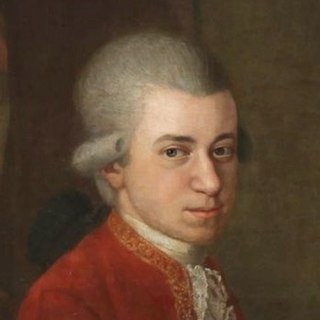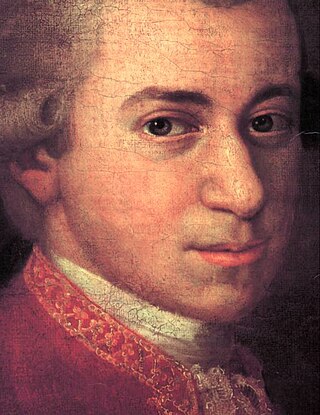Related Research Articles

Joseph Haydn's Symphony No. 13 in D major was written in 1763 for the orchestra of Haydn's patron, Prince Nikolaus Esterházy, in Eisenstadt.

The Symphony No. 94 in G major is the second of the twelve London symphonies written by Joseph Haydn. It is popularly known as the Surprise Symphony.

Ludwig van Beethoven's Symphony No. 1 in C major, Op. 21, was dedicated to Baron Gottfried van Swieten, an early patron of the composer. The piece was published in 1801 by Hoffmeister & Kühnel of Leipzig. It is not known exactly when Beethoven finished writing this work, but sketches of the finale were found to be from 1795.

The Symphony No. 104 in D major is Joseph Haydn's final symphony. It is the last of the twelve London symphonies, and is known as the London Symphony. In Germany it is commonly known as the Salomon Symphony after Johann Peter Salomon, who arranged Haydn's two tours of London, even though it is one of three of the last twelve symphonies written for Viotti's Opera Concerts, rather than for Salomon.

Symphony No. 35 in D major, K. 385, also known as the Haffner Symphony, was composed by Wolfgang Amadeus Mozart in 1782. It was commissioned by the Haffners, a prominent Salzburg family, for the occasion of the ennoblement of Sigmund Haffner the Younger. The Haffner Symphony should not be confused with the eight-movement Haffner Serenade, another piece Mozart wrote on commission from the same family in 1776.

The Symphony No. 1 in C minor, Op. 68, is a symphony written by Johannes Brahms. Brahms spent at least fourteen years completing this work, whose sketches date from 1854. Brahms himself declared that the symphony, from sketches to finishing touches, took 21 years, from 1855 to 1876. The premiere of this symphony, conducted by the composer's friend Felix Otto Dessoff, occurred on 4 November 1876, in Karlsruhe, then in the Grand Duchy of Baden. A typical performance lasts between 45 and 50 minutes.
Symphony No. 88 in G major was written by Joseph Haydn, for the orchestra of Esterháza under the benevolent Prince Nikolaus Esterhazy. It is notably the first of his symphonies written after the completion of the six Paris symphonies in 1786.

The Symphony No. 6 in D major is an early symphony written in 1761 by Joseph Haydn and the first written after Haydn had joined the Esterházy court. It is the first of three that are characterised by unusual virtuoso writing across the orchestral ensemble. It is popularly known as Le matin (Morning).

The Symphony No. 80 in D minor, Hoboken 1/80, is a symphony composed by Joseph Haydn in 1784 as part of a trio of symphonies that also included symphonies 79 and 81. This symphony, along with the one that follows it, and the one that precedes it, were not written for Prince Nikolaus, but for a Lenten concert performed in Vienna in March 1785. It is one of the relatively few later symphonies by Haydn to begin in the minor mode. Symphony No 80 is highly structured with both outer movements in sonata form. There is a common modulation pattern seen in all four movements.
The Symphony No. 75 in D major is a symphony composed by Joseph Haydn between 1779 and 1781.
Symphony No. 74 in E♭ major, Hoboken 1/74, is a symphony by Joseph Haydn composed in 1780 or 1781.

The Symphony No. 71 in B flat major, Hoboken I/71, is a symphony by Joseph Haydn. It was composed by 1780.

The Serenade No. 10 for winds in B-flat major, K. 361/370a, is a serenade by Wolfgang Amadeus Mozart scored for thirteen instruments: twelve winds and string bass. The piece was probably composed in 1781 or 1782 and is often known by the subtitle Gran Partita, though the title is a misspelling and not in Mozart's hand. It consists of seven movements.
The six String Quartets, Op. 76, by Joseph Haydn were composed in 1797 or 1798 and dedicated to the Hungarian count Joseph Georg von Erdődy (1754–1824). They form the last complete set of string quartets that Haydn composed. At the time of the commission, Haydn was employed at the court of Prince Nicolaus Esterházy II and was composing the oratorio The Creation as well as Princess Maria Hermenegild Esterházy's annual mass.

Joseph Haydn wrote his Symphony No. 8 in G major under the employ of Prince Paul II Anton Esterházy in Spring 1761, in the transition between the Baroque and Classical periods. It is the third part of a set of three symphonies that Prince Anton had commissioned him to write – Le matin, Le midi and Le soir. He had given him as inspiration the three times of Day.
The Complete Works of the Great Flutist is a collection of reissued and remastered recordings of performances by French flutist Marcel Moyse. The notes in the Muramastu Japanese site that markets the five CD box set only has English titles for the tracks, and has a number of mistakes regarding the playing order.

The Symphony No. 7 in C major, Hoboken I/7, is a symphony by Joseph Haydn, sometimes called "Le midi", meaning "The Noon."

Joseph Haydn's Symphony No. 15 in D major, Hoboken I/15, may have been written between 1760 and 1763.

The String Quartets, Op. 50, were composed by Joseph Haydn in 1787. The set of six quartets was dedicated to King Frederick William II of Prussia. For this reason the set is commonly known as the Prussian Quartets. Haydn sold the set to the Viennese firm Artaria and, without Artaria's knowledge, to the English publisher William Forster. Forster published it as Haydn's Opus 44. Haydn's autograph manuscripts for Nos. 3 to 6 of the set were discovered in Melbourne, Australia, in 1982.
References
- 1 2 Haydn, Johann M. Serenade in D. 1767. Bad Reichenhall: Comes Verlag, 1987. Print.
- 1 2 Shaffer, Kris. "Menuet Form." Open Music Theory. Ed. Robin Wharton. Hybrid Pedagogy Publishing, n.d. Web. 31 Mar. 2016. <http://openmusictheory.com/minuet.html>.